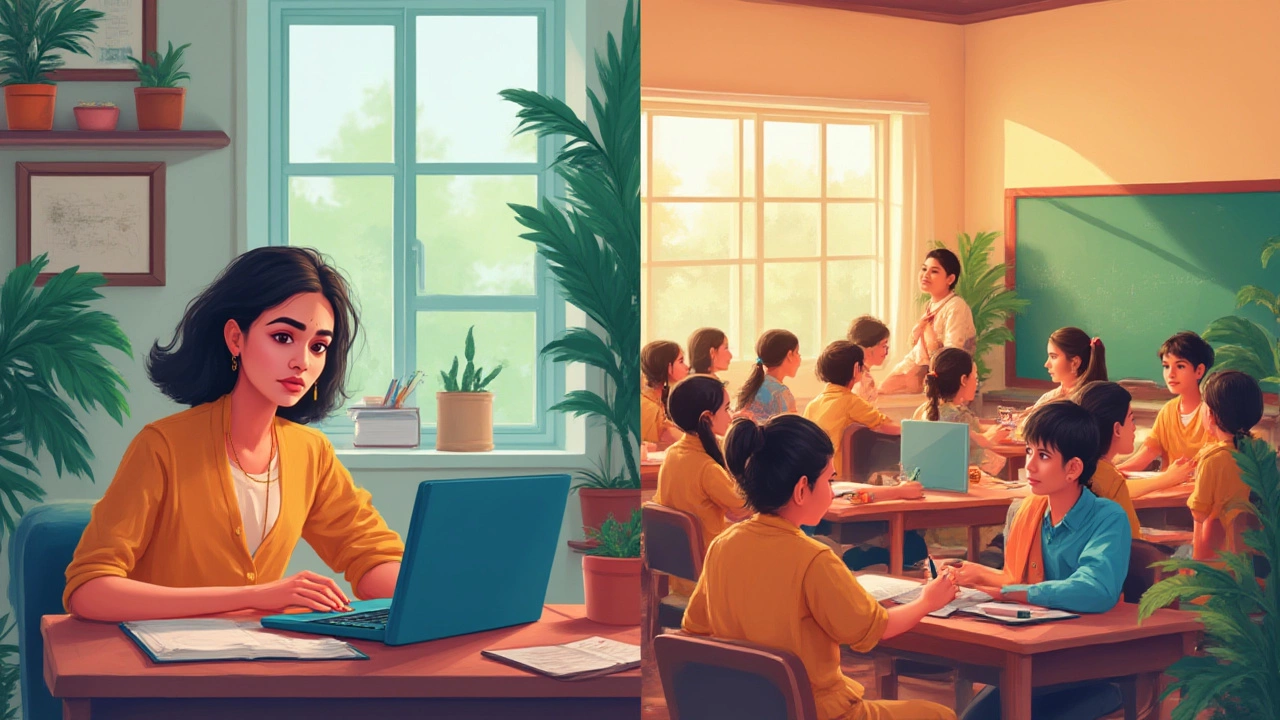Felix, my cat, once sat on my keyboard during a Zoom college lecture, flirting with a sea of confused students popping up in little boxes. That’s the thing about eLearning—you never know what’s going to happen next. Digital distractions, pajama dress codes, and screen-shared slides are now as much a part of learning as chalkboards and pop quizzes. The world has changed fast, and so has how we learn. But is all this online education really that different from showing up to a classroom with a stack of notebooks and a mug of probably-too-hot coffee? Turns out, the gap is bigger than most of us think. Let’s break it down by looking at the real differences between eLearning and traditional classroom learning.
Learning Environment and Flexibility
eLearning means you can take a class just about anywhere: from your bed, a coffee shop, even during a long train ride—assuming you can focus over the rattle of the tracks, of course. There’s major flexibility here. Students pick their study spot, their schedule, and sometimes even the pace of their lessons. The technology lets you hit pause on lectures, rewind for clarification, or skip ahead if you’re feeling confident. That’s a pretty big deal for folks who work late, have family commitments, or just aren’t morning people. Plus, eLearning doesn’t care if you’re wearing mismatched socks or sipping last night’s cold coffee as you watch a physics demo at 2 a.m.
But flip the script, and the traditional classroom is a totally different animal. Here, you’ve got a set location and a fixed schedule. Lessons start at a specific time, the bell rings, and there’s everyone—all together in one place. If you show up late, everyone notices. The atmosphere’s more controlled. It's also shaped by routine: the familiar hum of voices, the scratch of pens, the mildly uncomfortable desks. This structure helps a lot of people focus—it’s easier to tune out the lure of the fridge or a phone buzzing with texts from friends. On top of that, some research has shown that face-to-face instruction offers fewer distractions and helps students retain information better through physical cues and social oversight.
So, how about real-life impact? Well, eLearning scored big points during the pandemic. Massive open online courses (MOOCs) saw enrollments jump by millions in just a few months back in 2020. Suddenly, geography stopped mattering. Someone in Texas could take a coding bootcamp in Berlin, while a medical student in India followed Harvard lectures. But this freedom has its flip sides. Without a schedule or a teacher side-eyeing your phone use, it’s easy to procrastinate or zone out. Flexibility becomes a double-edged sword. The so-called freedom can easily slide into a lack of routine, making it tough for some folks to stay motivated.
Here’s a tip: if you jump into eLearning, create micro-routines. Block out time on your calendar, set reminders, and stick to a dedicated study space—even if it’s just a corner of your room or your favorite spot at the kitchen table (watch out for the hungry cat).
Interaction and Social Connection
Human connection makes a difference in how we learn. In the classroom, you’re surrounded by a living, breathing group: hand-raisers, chatterboxes, silent thinkers, and the occasional joker. The back-and-forth is real. When a teacher asks a question, you see hands shoot up—or folks shrinking into their hoodies, hoping not to be called on. There’s group work, hallway conversations, and sometimes, a respectful debate that starts in class but ends over lunch. These human touches build relationships and help with collaboration. Students bounce ideas off each other, get quick feedback, and pick up non-verbal clues. Those moments often build confidence and lasting friendships.
Online, building genuine connections takes extra effort. There are forums, chat boxes, Zoom breakout rooms, and digital hand-raising features, but the vibe is different. Interactions are often typed, not spoken, and direct communication can feel stilted or easy to ignore. It’s less natural to pull someone aside after class for a quick word. Plus, let’s admit it—not everyone wants their webcam on, especially on a bad hair day. Feedback is mostly written and sometimes delayed by hours or even days. Group projects can suffer, too, when students don’t know each other or communicate only through clunky email chains.
That said, some thrive online. Shy students who might never speak up in person sometimes find their voices in discussion forums. eLearning’s digital wall offers a safety net: more time to think through responses and the chance to research answers before hitting “send.” Some platforms even assign group work across countries, adding a global twist to collaboration. The trade-off, though? It takes intentional planning to keep students engaged and feeling connected. Without that, eLearning can get lonely fast, and isolation can zap both motivation and learning outcomes.
Want to make the most of either setting? In a classroom, introduce yourself, start small talk, or join a study group. Online, use direct messages, video chats, or virtual study sessions—don’t wait for someone else to break the ice. Interactivity is a big deal: surveys in 2023 found that courses with higher peer-to-peer interaction reported much better completion rates and higher satisfaction. No surprise there—connection is key.

Instruction Methods, Technology, and Engagement
How we absorb new information depends a lot on how it’s delivered. In the classroom, there’s chalk-and-talk, sure, but also hands-on activities, labs, real-time debates, and good old-fashioned written tests. The teacher can adjust on the fly: if students look confused, maybe slow down or use a different explanation. Visual learners get the benefit of live demonstrations, while auditory learners pick up on vocal cues. The physical environment sets the tone for focus and interaction—a teacher standing in front signals ‘pay attention’ in a way a screen never does.
With eLearning, teaching tools have gone wild. There’s video, interactive quizzes, clickable maps, bite-sized podcasts, and instant feedback modules. One-size-fits-all disappears—adaptive learning platforms will tweak material in real time based on your quiz results or time spent on a slide. Want a review? The “rewind” button’s always there. Need extra help? Some online courses offer AI-powered tutoring bots available 24/7. You can download digital flashcards, join live webinars, or even do group presentations over video call, projecting your big ideas across continents. But too much tech can backfire—when glitches hit, internet drops, or the learning management system crashes mid-assignment, panic sets in. Not everyone is tech-savvy, and technical issues are ranked as one of the top frustrations by remote students, according to a national survey done last year by Inside Higher Ed.
Engagement is trickier online. Teachers are now competing with social media, pop-up ads, and literally anything else open in your browser tab. Some eLearning systems tackle this by gamifying material—awarding badges, unlocking content “levels,” or using leaderboards. Small nudges add motivation, but distractions are always just a click away. That means online students need strong self-discipline, while classroom learners benefit from physical presence and immediate oversight.
Pro tip: whether you’re online or off, experiment with different study strategies. Try active recall (testing yourself without notes), spaced repetition apps for memorization, or the Pomodoro technique (study focused for 25 minutes, then break). For online learners, keep apps and browser tabs closed that aren’t linked to your course. Tiny tweaks can mean less stress and better results, no matter where you’re learning.
Results, Recognition, and Future Outlook
At the end of the day, what everyone wants to know is: does eLearning actually work as well as classroom learning? The honest answer is—it depends. A large-scale study from the U.S. Department of Education in 2022 found that students in online-only courses typically performed slightly worse than their face-to-face peers, although blended (hybrid) learners often scored the best. Why? Online-only students had a tougher time staying engaged, while hybrids benefitted from flexibility and personal interaction. Another finding: students with lots of tech support at home or previous self-motivation skills did better online than those new to digital learning or lacking resources.
Recognition matters, too. Employers used to be skeptical of online certificates, but things are shifting fast. Now, over 70% of U.S. hiring managers say an accredited eLearning degree is “just as reliable” as a traditional one, especially in tech, business, and healthcare fields. Many top universities now offer the same diploma to both online and in-person grads—no asterisk, no footnote. Still, some careers (think nursing, engineering, culinary arts) will always need hands-on practice in the real world. Nothing beats learning to stitch a wound or perfect a soufflé in person.
There’s no sign that eLearning will fade away—if anything, it’s only growing. New platforms add VR, AR, holographic teachers, and smart algorithms that update your syllabus on the fly. Will it ever fully replace classroom learning? Probably not. Most experts predict a blended model, mixing the best of both worlds: convenience and resources of online plus the social and hands-on perks of in-person. If you’re weighing your options, ask yourself which style suits your needs, personality, and lifestyle. If you’re a self-starter juggling a hundred things, eLearning could be your best bet. If you crave routine, camaraderie, and structured support, that classic classroom might still have the edge.
No matter where or how you learn, remember: the magic’s in the effort, not just the setting. My best advice? Don’t be afraid to try both methods, mix them up, and figure out what actually makes things click for you. Whether you’re learning at a campus desk, a kitchen table—or even with an opinionated cat on your lap—the most important thing is that you’re curious, committed, and willing to keep growing. That’s a lesson that fits anywhere.
